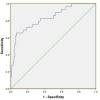Pre-procedural TMAO as a predictor for recurrence of atrial fibrillation after catheter ablation
- PMID: 39732662
- PMCID: PMC11681644
- DOI: 10.1186/s12872-024-04170-w
Pre-procedural TMAO as a predictor for recurrence of atrial fibrillation after catheter ablation
Abstract
Background: Numerous studies have demonstrated the significance of trimethylamine-N-oxide (TMAO) in the progression of atrial fibrillation (AF). However, the association between TMAO and AF recurrence (RAF) post-catheter ablation is not yet fully understood. This study aims to elucidate the predictive capability of pre-procedural TMAO levels in determining RAF following catheter ablation (CA).
Methods: This study was conducted as a prospective, single-center observational study. Between June 2021 and June 2022, 152 patients from the Department of Cardiology at The Affiliated Huaian No. 1 People's Hospital of Nanjing Medical University were enrolled. Baseline characteristics and serum TMAO levels were assessed for all participants. Patients with AF who underwent CA were monitored for recurrences of AF using electrocardiography (ECG) or 24-hour Holter monitoring during the follow-up period.
Results: The study found that serum TMAO levels were significantly higher in persistent AF (PeAF) patients compared to those in sinus rhythm (SR) and paroxysmal AF (PaAF) patients (3.96 ± 1.69 vs. 1.81 ± 0.59, 3.02 ± 1.50 µM, P < 0.001 and P < 0.01, respectively). After a one-year follow-up, 29 (21.2%) AF patients experienced recurrence after CA. Multivariate Cox proportional hazards regression analysis revealed that pre-procedural serum TMAO was an independent predictor of recurrent AF (HR = 1.78, 95% CI = 1.43-2.21, P < 0.001). The receiver operating characteristic (ROC) curve analysis identified a cut-off value of 4.3µM for serum TMAO levels in predicting recurrent AF (area under the curve: 0.835, P < 0.001). The Kaplan-Meier plot demonstrated that patients with TMAO levels greater than 4.3µM had a significantly higher rate of recurrent AF (HR = 13.53, 95% CI = 6.19-29.56, P < 0.001).
Conclusion: Patients with AF exhibited elevated levels of circulating TMAO compared to patients with SR. The findings suggest a potential role of TMAO in the development of AF, with pre-procedural serum TMAO levels serving as a reliable predictor of recurrence of AF CA.
Keywords: Atrial fibrillation recurrence; Catheter ablation; Predictor; TMAO.
© 2024. The Author(s).
Conflict of interest statement
Declarations. Ethics approval and consent to participate: This study was approved by the ethics committee of Huai’an First People’s Hospital, and all patients involved signed informed consent. The methods used in this study were conducted in accordance with relevant guidelines and regulations. Competing interests: The authors declare no competing interests.
Figures




Similar articles
-
Impact of Midregional N-Terminal Pro-Atrial Natriuretic Peptide and Soluble Suppression of Tumorigenicity 2 Levels on Heart Rhythm in Patients Treated With Catheter Ablation for Atrial Fibrillation: The Biorhythm Study.J Am Heart Assoc. 2021 Jul 6;10(13):e020917. doi: 10.1161/JAHA.121.020917. Epub 2021 Jun 30. J Am Heart Assoc. 2021. PMID: 34187182 Free PMC article.
-
The soluble ST2 level predicts risk of atrial fibrillation recurrences in long-term period after radiofrequency ablation.BMC Cardiovasc Disord. 2024 Aug 28;24(1):460. doi: 10.1186/s12872-024-04119-z. BMC Cardiovasc Disord. 2024. PMID: 39198735 Free PMC article.
-
[Left atrial appendage volume is a valuable predictor of atrial fibrillation recurrence after radiofrequency catheter ablation].Zhonghua Xin Xue Guan Bing Za Zhi. 2017 Nov 24;45(11):924-929. doi: 10.3760/cma.j.issn.0253-3758.2017.11.006. Zhonghua Xin Xue Guan Bing Za Zhi. 2017. PMID: 29166717 Chinese.
-
The role of preprocedural monocyte-to-high-density lipoprotein ratio in prediction of atrial fibrillation recurrence after cryoballoon-based catheter ablation.Europace. 2015 Dec;17(12):1807-15. doi: 10.1093/europace/euu291. Epub 2015 May 19. Europace. 2015. PMID: 25995388
-
Recurrent atrial fibrillation markers post radiofrequency catheter ablation.Clin Chim Acta. 2025 Feb 15;568:120126. doi: 10.1016/j.cca.2025.120126. Epub 2025 Jan 9. Clin Chim Acta. 2025. PMID: 39798686 Review.
References
-
- Mozaffarian D, Benjamin EJ, Go AS, et al. Heart disease and stroke statistics–2015 update: a report from the American Heart Association. Circulation. 2015;131(4):e29–322. 10.1161/CIR.0000000000000152. - PubMed
-
- Waldmann V, Jouven X, Narayanan K, et al. Association between Atrial Fibrillation and Sudden Cardiac Death: Pathophysiological and epidemiological insights. Circ Res. 2020;127(2):301–9. 10.1161/CIRCRESAHA.120.316756. - PubMed
-
- Lippi G, Sanchis-Gomar F, Cervellin G. Global epidemiology of atrial fibrillation: an increasing epidemic and public health challenge. Int J Stroke. 2021;16(2):217–21. 10.1177/1747493019897870. - PubMed
-
- Tilz RR, Rillig A, Thum A-M, et al. Catheter ablation of long-standing persistent atrial fibrillation: 5-year outcomes of the Hamburg sequential ablation strategy. J Am Coll Cardiol. 2012;60(19):1921–9. 10.1016/j.jacc.2012.04.060. - PubMed
Publication types
MeSH terms
Substances
Grants and funding
LinkOut - more resources
Full Text Sources
Medical
Research Materials
Miscellaneous

